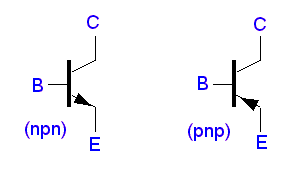The transistor is the fundamental building block of modern electronic devices, it is a semiconductor device used to amplify and switch electronic signals.
More simply a transistor is a valve for electricity. In this video I demonstrate the two types of transistors (NPN and PNP) and explain their uses.
Here are the two symbols for transistors a NPN and a PNP.

Here are the two symbols for transistors a NPN and a PNP.
A transistor is a valve uses to control electron flow or current flow. Essentially you place a small amount of current on the base of the transistor (B in image above) to flow to the emitter and a much larger current can flow from the Collector to the emitter. There are two types of transistors NPN and PNP. NPN stands for Negative Positive Negative, PNP stands for Positive Negative Positive, this indicates rather a positive or negative current placed on the base will turn the transistor on. If you take a multi meter to test a PNP transistor you can hold the negative lead on the base and use the positive probe on the outer two terminals to read resistance, vice versa on a NPN.
Further reading http://en.wikipedia.org/wiki/Transistor
